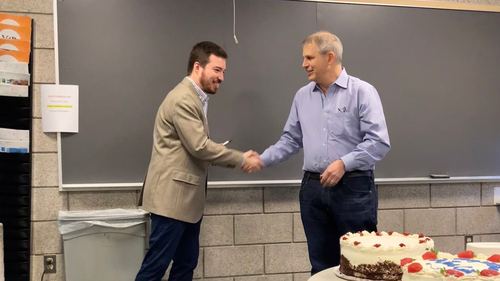
On November 17, Jacob Curtis successfully defended the thesis “Error Mitigation and Detection in Circuit Quantum Electrodynamics Powered by QND Measurements” (advisor: Robert Schoelkopf).
Curtis explained, “Current error rates in quantum computers prevent the realization of the most exciting applications in quantum chemistry and factorization. To reach error rates suitable for these algorithms, we need quantum error correction, which utilizes redundant physical qubits to construct logical qubits with lower error rates than any individual physical qubit. However, many expect that millions of physical qubits are required for useful quantum computations. Recent proposals have shown that constructing physical qubits that detect their failures lowers the number needed per logical qubit. My thesis work constructs and characterizes an error-detected gate on a physical qubit. This gate detects its dominant errors and reaches high fidelity in their absence.”
His next position will be as a Quantum Engineer at Quantum Circuits Incorporated.
Thesis abstract:
Superconducting cavities coupled to transmon ancillae is a promising platform for fault-tolerant quantum computation. This pairing produces universal control over a long-lived bosonic mode, in whose many levels we encode a logical qubit or physical quantum system, such as the vibrational modes of a molecule. However, unwanted static interactions and spurious couplings to the environment limit the accuracy of computations. In this dissertation, we tackle each of these error sources in turn. Our solutions exploit the ability of the transmon to perform high-fidelity measurements of the cavity mode without disturbing its stored information. First, we present our efforts to reduce the residual cavity non-linearity, which causes dephasing in many quantum codes. We discuss multiple methods to measure the non-linearity and show that our mitigation technique can fully cancel cavity self-Kerr. Next, we construct a new photon-number resolving measurement that extracts multiple bits of information from the cavity in a single shot using multiple transmon measurements. The errors that occur in this measurement have a predictable form and can be inverted to reduce ensemble error by an order of magnitude. Finally, we develop and demonstrate a gate that detects errors in real time. The resources required for fault-tolerance are high, but can be relaxed if the goal is only to detect, but not correct errors. Our error-detected gate reduces infidelity by a factor of 22 due to improvements in numerical gate optimization and transmon three level control.